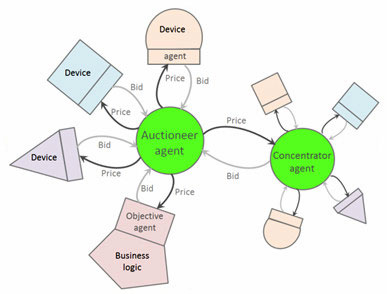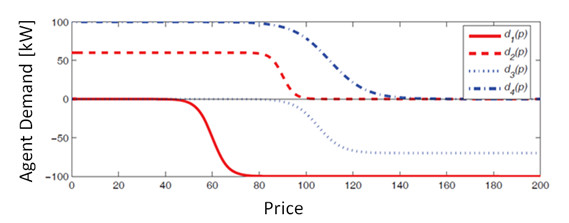Agent based technology
Matching supply and demand
Agent based technology can be used to match supply and demand of energy. Let's take the case of electricity. All consumers and producers of electricity are represented by an agent, connected to a power matching auctioneer agent, as illustrated below.

Agents representing devices operating in a market with an auctioneer agent
Each agent offers a bid to the auctioneer in the form a bid curve, illustrated in the figure below. The bid curve shows how much electricity the device is willing to supply or consume at different prices. Producers of electricity are generally interested in supplying electricity at high prices. This is reflected in the red curve below, where production is denoted as negative demand. Consumers on the other hand are interested in consuming electricity when the price is low, reflected by the blue dotted line.

Bid curves offered by the agents to the auctioneer agent
The auctioneer aggregates all bids and arrives at a price at which electricity demand and supply are matched. Each device then receives or produces an amount of electricity that corresponds to the amount of electricity in its bid curve at this price.
The price of energy rises when demand is high and supply is low
If the auctioneer determines a price that is too high for certain consumers then no electricity will be supplied to them. As a result, a consumer e.g. a refrigerator, may see its internal temperature increasing and in the next time step it will be willing to pay a bit more for electricity by modifying its bid curve. In this way higher prices can stimulate supply at critical times and lower prices will stimulate demand when there is an adequate supply: energy supply can be balanced by load shifting.
Balancing energy demand by load shifting
When sufficient agents are in the network, with each trying to satisfy its own interests, the overall result is that, on a macro level, electricity supply and demand are matched at the lowest (dynamic) price by the district energy management system.
Currently, the price is used as a means to arrive at a match of supply and demand. However, the mechanism offers the possibility, through an ‘objective agent’ or ‘business agent’ to represent external factors to affect the price on the energy market, satisfying the interests of a particular stakeholder. This allows for energy management at the district level.
An example of agent based technology is the Powermatcher © originally developed by ECN. Since its incarnation in 2004, the PowerMatcher has been implemented in three major software versions, of which the first two were tested in simulations and field experiments. The development of the third version is completed and it is currently being tested in a number of projects like PowerMatching City in the city of Hoogkerk, The Netherlands and a real-life demonstration on the island of Bornholm in the frame of the Ecogrid project. Watch the video by Integral. Approx 4 minutes on a fast connection.
TNO and a number of associated partners such as energy suppliers, DSOs (Distribution System Operators) and TSOs (Transmission System Operators) are aiming to set the Powermatcher as the standard for operating smart grids. They are organising themselves in the Flexible Power Alliance Network.
ICAX has developed controls to allow heat pumps in fifth generation district heating networks to respond to demand side response.
